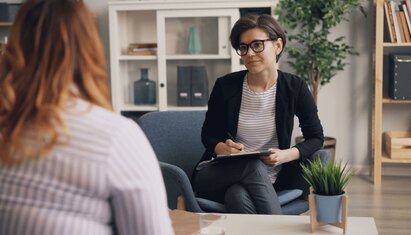Why I chose to start a nonprofit group therapy practice (and why you might, too)



Published December 15, 2020

It’s clear, listening to Bell Tam speak, that he’s a natural educator. He has a small model of a human body within arm’s reach, and reaches for it instinctively several times to illustrate his point. It’s also clear the shift to virtual care and learning hasn’t slowed him down one bit. Although we spoke over a video call, he knew where to position the model so I could see it, and how to demonstrate backwards so it would be correct for me.
It makes sense, really—being an educator runs in the family. The Tams run an acupuncture practice in the Boston area. Since the beginning, Bell’s parents Tom and Lea Tam have placed an emphasis on sharing their knowledge, both with their children and their community.
Although Tom and Lea are now retired from acupuncture, Bell and his sister are running their three clinics using the unique approach their parents developed in their nearly forty years of private practice.
When the Tams opened their practice in the 1980s, they were the first acupuncturists in their area. “At the time, acupuncture wasn’t super common here. But it was their calling, so they set their career on this path,” Bell tells me. “Today, acupuncture has become a lot more popular—not just in Boston, but all over the country and all over the world.”
While acupuncture in general is becoming more widely used, and has more insurance coverage options, the Tams’ approach to acupuncture is unique to their practice—and brings clients in from all over.
“We have people traveling from all over the country to see us, and a lot of that has to do with our approach to acupuncture,” Bell explains. “A lot of people come to us because they feel like they’re out of options, or they’re frustrated with the care they’re getting in the traditional healthcare system.”
Bell goes on to explain that the classic approach to acupuncture focuses on Meridian theory, which examines how different pathways along the body influence other areas, like a specific organ or function of the body. Their approach is similar, in that it uses the same tool set of fine-tip needles, and draws heavily on the teachings of traditional acupuncture. The main difference, Bell says, is where their focus is placed.
“Instead of looking at treatment through the Meridian perspective, we’re focusing more on what we call physical blockages,” he says. “We work primarily along the neck and back, because we’re really interested in the spine—the central nervous system.”
The model makes its’ first appearance as we talk about the central nervous system. Using a pen to point as he speaks, Bell explains that each section of the spine, down to each specific vertebrae, has nerve endings that fan out throughout the body.
In the case of a lung issue, for example, they would focus on the vertebrae in the upper back, because nerves travel from the brain through that part of the spine and then into the lungs. “By taking this approach, we’re addressing some of the circulation issues that might be causing the problem in the lungs,” he says.

Aside from the shift in their focus, the Tams also utilize a manual form of therapy called tui na massage, which focuses more on muscle tissue.
Bell says he took only a short class on tui na when he was studying to become an acupuncturist, since it’s not the main focus in traditional acupuncture practice. Watching his parents practice from such a young age, he was able to observe how much the spine relates to a lot of health issues. Their practice utilizes manual therapy in addition to traditional acupuncture to relieve pain and discomfort.
“What we’re trying to do is loosen up the muscles,” he explains. “That allows more of the blood vessels and nerves to get the circulation they need. If we can understand how the muscles protect certain areas from an anatomical perspective, we can understand how they can impede access to those areas as well. Then we can really focus there and alleviate that blockage, and get the circulation moving.”
“You can treat symptoms, but unless you identify the root cause of the problem, you’ll never actually feel any better.”
Bell and his family have had a lot of success using this method. It’s worked for things as simple as pain issues, but also for more complicated concerns, like cancer or neurological issues. Another key part of their practice, he says, is using advancements in medical knowledge to approach specific issues more holistically.
“I like to tell people to imagine you have a flat tire with a nail in it. You can pump the tire full of air, but you’re not really fixing the problem, which is the nail. Unless you find where the nail is, and then ask how to get rid of the nail, you’re just going to be pumping air into the tire forever,” he says. “The body is the same way. You can treat symptoms, but unless you identify the root cause of your problem, you’ll never actually feel any better.”
For the Tams, a holistic approach doesn’t just mean physical—they focus on the spiritual aspect as well. Tong Ren healing is a treatment method that was developed by Bell’s father, Tom Tam, in the early 90s. A client came in with sciatica, but Tom didn’t have any clean needles available. As an experiment, Tom drew a figure on a piece of paper, and placed the needles on the drawing where he would on his client. Over the course of a few minutes, Bell tells me, the client began to feel their pain subside.
“I explain it as a cross between energy healing and meditation,” Bell says. “You focus on an area with the intention of opening that blockage. So it’s a more indirect method of healing than acupuncture or massage, but what we see when doing this treatment is a lot of people feel very calm and relaxed. It has parallels to meditation, where it brings down your brainwaves so they almost mimic the pattern of sleep. Sleep is when your body starts to repair. So when you drop into that state, it does create some of those same benefits—rest, repair, restoration.”
Bell’s gotten feedback from clients who have experienced Tong Ren healing that it’s helped them with issues that traditional medicine wasn’t able to address. The Tams are clear that Tong Ren isn’t meant to be a replacement for medical care, but rather a way to get another perspective that might lead to a result.
“By looking at some of these issues from different angles, what we’re really asking is, can we address this better? Is there another way to help this person that might have different results?” Bell says.

Tom Tam has been teaching some form Tong Ren classes in Boston for thirteen or fourteen years. The pandemic interrupted their ability to continue teaching in person, since as many as 80 people would come to each class. But they’ve continued to offer the classes online throughout 2020.
For Tom, Bell tells me, teaching these classes is a chance to share his knowledge and passion, but it’s also a chance for him to offer an important—and free—resource to people who might
need it.
“The online classes have been especially great, because it’s a chance for people to get a resource they didn’t have access to before,” Bell says. “They give people the space and perspective to look at their health in a different way, or to get some answers they might not have been able to
find elsewhere.”
As Bell’s parents have retired, he and his sister have taken over running the day-to-day aspect of the practice. And although running three different locations takes up a lot of his time, for Bell, education remains a key focus.
“One of the goals I have with this practice is really to educate people,” he says. “My mom and dad gave us this knowledge and showed us what it means to help other people with it. I don’t think there’s a more noble cause than that. If I’m in a position to help others, and give them answers, that’s the most rewarding part of this work for me.”
SimplePractice is HIPAA-compliant practice management software with everything you need to run your practice built into the platform—from booking and scheduling to insurance and client billing.
If you’ve been considering switching to an EHR system, SimplePractice empowers you to streamline appointment bookings, reminders, and rescheduling and simplify the billing and coding process—so you get more time for the things that matter most to you.
Try SimplePractice free for 30 days. No credit card required.

Lauren Diethelm is a writer and editor living in Reno, Nevada. She was previously content marketing manager for SimplePractice.
Proudly made in Santa Monica, CA © 2026 SimplePractice, LLC
Proudly made in Santa Monica, CA © 2026
SimplePractice, LLC